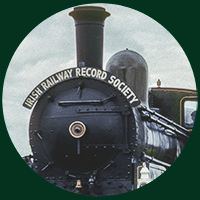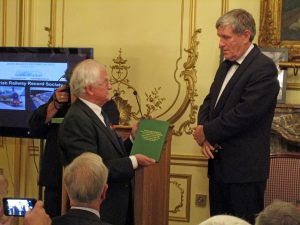A record of previous meetings organised by the IRRS from Dublin, Cork and London (2014 – 2018)
2018 Meetings
- 6 December 2018 (London) – “Listowel to Cobh, 1978 1986” by London Area member Gerry McMahon
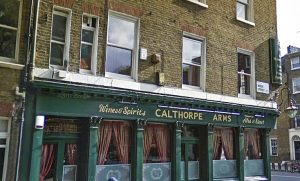 Gerry McMahon shared his splendid memories of railways in the Tralee area in the 1970’s and 1980’s with a capacity audience at the London Area on 6 December. He reminded us of rural railway operations at the time when nothing had changed since the steam age apart from the traction. We saw long lost goods yards, branches, stations and semaphore signalling. We saw loose-coupled wagonload and beet trains. We saw steam cranes in use by the civil engineering department. We saw shunting by gravity and by cable.
Gerry McMahon shared his splendid memories of railways in the Tralee area in the 1970’s and 1980’s with a capacity audience at the London Area on 6 December. He reminded us of rural railway operations at the time when nothing had changed since the steam age apart from the traction. We saw long lost goods yards, branches, stations and semaphore signalling. We saw loose-coupled wagonload and beet trains. We saw steam cranes in use by the civil engineering department. We saw shunting by gravity and by cable.
We appreciated the experiences, skills and teamwork of a bygone era of railwaymen who made it all work. Gerry’s memories of the time were vivid and comprehensive and brought it all alive once again.
- 15 November 2018 (London) – “Current & Future Fleet Developments on Irish Rail” by Peter Smyth (Chief Mechanical Engineer – Iarnród Éireann)
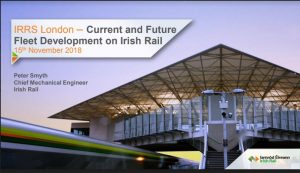
On 15 November 2018, Peter Smyth (CME, Irish Rail) gave the London Area a comprehensive update on current IR fleet operations and management, explaining how new technology is transforming the efficiency of the fleet in a way never possible before. There are also many incidental benefits, such as using computer records to refute regular passenger claims for compensation relating to faulty rolling stock! Peter also gave us an eye-opening insight into future fleet options for Irish Rail. As we approach the end of the diesel-only trains era, the options for future fleet technologies are many – bimodes, DEMU’s, BEMU’s etc. all aimed at reducing the environmental impact of train operations and reducing whole-life fleet costs. We seem to be on the cusp of a traction transformation almost as profound as that from steam to diesel 50 – 60 years ago.
- 27 September 2018 (Dublin) – Slideshow: “From Derry to Kerry, 1955 to 1958” by IRRS Photographic Archivist Ciarán Cooney
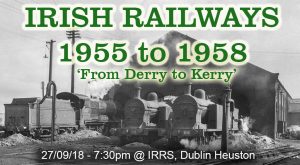 On 27 September 2018, the Society’s Hon. Photographic Archivist, Ciaran Cooney presented a slideshow under the title “From Derry to Kerry, 1955 to 1958 – pictures by Anthony E Bennett.”
On 27 September 2018, the Society’s Hon. Photographic Archivist, Ciaran Cooney presented a slideshow under the title “From Derry to Kerry, 1955 to 1958 – pictures by Anthony E Bennett.”
The presentation illustrated the Irish railway network during the years 1955-1958, as recorded by the late British based photographer Anthony E Bennett, who made three visits to Ireland during the 1950s, journeying on what was then an extensive railway network and encompassed railways in each county of Ireland, including the former Great Northern Railway lines in the north west, the narrow gauge Cavan & Leitrim Railway system and the erstwhile CIE branch lines in the south and west of the country, such as Ballinrobe, Loughrea, Valentia and Kenmare to name but a few. Bennett’s travels also document the wide variety of Irish steam locomotives then still operating during the 1950s and which were slowly giving way to diesel traction. 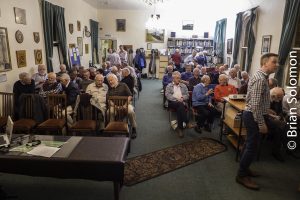
In addition to their physical conservation treatment, each picture was carefully digitised and restored for presentation. The large attendance at the meeting recorded their warm appreciation of Ciaran’s restoration work on this important collection. Ciaran in turn paid tribute to John Langford for arranging for Tony Bennett’s material to donated to the Society, and to Michael and Jerry Walsh organizing transport, from Long Eaton to Dublin, of the Bennet collection and a very substantial further body of material from John Langford personally. The Society is also pleased to acknowledge John Langford’s support and generosity in this and other matters over very many years.
- 26 April 2018 (Dublin) – “The End of an Era – the Changing World of the ‘60s. The Final Days of UTA Steam and Railcars” slideshow presented by Derek Young
Many will know Derek as the author of the book “Ulster Transport Authority in Colour”, published some twelve years ago now in 2006. Members on the night were treated to mostly unseen images of Derek’s collection that couldn’t be included in the book, as well as the odd image from other collections. The presentation covered the steam and diesel trains operated by the UTA in the 60’s, and also included scenes from the Bangor line, the NCC Derry line, early diesels, NCC engines on the GNR, and special trains such as the famous spoil trains on the Larne line. Other photos featured scenes of York Road and numerous shots of the ‘Jeeps’, which were once commonplace on the network. Derek’s presentation brought to an end the current Indoor Programme and what a show it was, definitely not one to be missed!
- 19 April 2018 (London) – “The GNR(I) lines to Newcastle and Derry” by Charles Friel
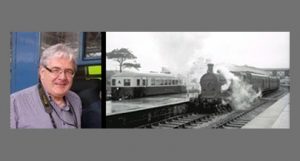 Charles Friel gave another excellent presentation to the IRRS London Area on 19th April – the last Area meeting of the season. It was a Great Northern-themed evening. The first half showed a great collection of previously unseen photos of the line from Knockmore Junction – Newcastle, including the Scarva branch. Only four members of the audience had travelled on the line, although at least one was a babe-in-arms at the time!
Charles Friel gave another excellent presentation to the IRRS London Area on 19th April – the last Area meeting of the season. It was a Great Northern-themed evening. The first half showed a great collection of previously unseen photos of the line from Knockmore Junction – Newcastle, including the Scarva branch. Only four members of the audience had travelled on the line, although at least one was a babe-in-arms at the time!
In the second half, Charles introduced a recording of a BBC programme about the Derry road made to mark the 50th anniversary of its closure in 1965. The programme included film at almost every station on the line and dwelt at some length on the people who operated the line and the circumstances of its closure. More of the audience remembered this route and the programme was a poignant reminder to all of what has gone.
- 12 April 2018 (Dublin) – “Architecture of the Great Northern Railway Ireland” by Siobhan Osgood
Siobhan previously gave members a 10 minute ‘preview’ of her presentation during the Members Slideshow in Nov 2016, which was well received, resulting in the full talk being presented here. Using engaging visuals of original drawings alongside photos of current buildings, Siobhan detailed the development of the GNRI’s central engineering works at Dundalk, focusing on the work of its first chief engineer, William Hemingway Mills. Starting with the engineering works, Siobhan linked key architectural features across residential and railway station buildings, including those inherited from the earlier site and those constructed by the GNRI. The second part of the talk was an open Q&A session with attendees on the night.
- 22 March 2018 (Dublin) – Annual Film Show: “From Midland Branches to the Suir Valley”, an evening dedicated to the gems recorded on film by Joe St Leger, presented by Ciaran Cooney and Liam Mooney
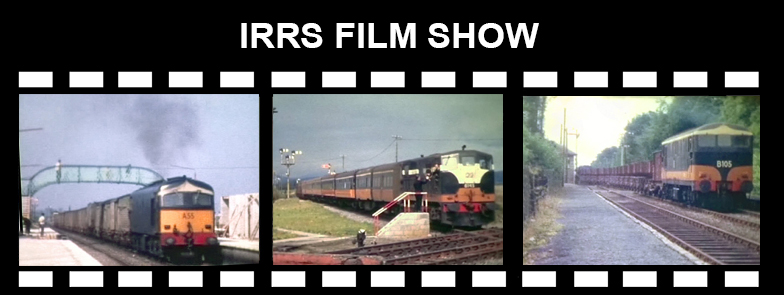 One of the highlights of the indoor programme, if not the highlight, is the Annual Film Show, which took place on 22nd March this year. Members were in for a treat when the meeting got under way after a slightly delayed start due to the AGM over running. Now in its third year of the ‘new’ digital format, Ciaran Cooney and Liam Mooney presented the film show, “From Midland Branches to the Suir Valley”, dedicating the evening to the gems recorded by Joe St. Leger.
One of the highlights of the indoor programme, if not the highlight, is the Annual Film Show, which took place on 22nd March this year. Members were in for a treat when the meeting got under way after a slightly delayed start due to the AGM over running. Now in its third year of the ‘new’ digital format, Ciaran Cooney and Liam Mooney presented the film show, “From Midland Branches to the Suir Valley”, dedicating the evening to the gems recorded by Joe St. Leger.
Ciaran showed several of Joe’s films with some breathtaking footage including the likes of the Mallow – Waterford line, Loughrea and Ballina branches, either side of Liam presenting his own footage of the many types of freight that were once commonplace on the network, by spending a typical evening in the Co. Kildare countryside. The endless hours of behind-the-scenes work put in by Ciaran to digitalise and edit the films, (not to mention the thousands of slides!) was acknowledged by those present at the end of the meeting. Unsurprisingly, this was the most attended event of the programme thus far, with 75 members present.
- 15 March 2018 (London) – “Further Tales of Irish Railway Travel in the mid-1950s” by Michael Davies
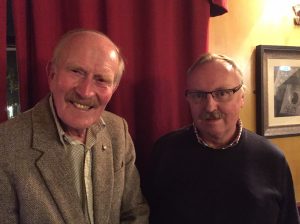 Michael transported the audience, with members visiting from Wales, Scotland and Ireland, back to 1950s Letterkenny (by the Swilly and the Donegal), the length of the Cavan and Leitrim (clearly his favourite), the Midland Great Western from Inny Junction to Cavan and on to Clones by the Great Northern. Michael was also in time to travel several times on the Sligo Leitrim and Northern Counties before that singular railway closed.
Michael transported the audience, with members visiting from Wales, Scotland and Ireland, back to 1950s Letterkenny (by the Swilly and the Donegal), the length of the Cavan and Leitrim (clearly his favourite), the Midland Great Western from Inny Junction to Cavan and on to Clones by the Great Northern. Michael was also in time to travel several times on the Sligo Leitrim and Northern Counties before that singular railway closed.
Along the way, Michael made many enduring friends among Irish railwaymen and recounted how when a rail connection was not available he used buses and on many occasions hitched a lift with commercial travellers and on one occasion, a parish priest. While exploring the Cavan and Leitrim one Sunday, he obtained the loan of a bicycle, but a tyre succumbed to the rough roads. Nothing daunted, he discovered a cycle repair business in the next town, knocked on the door, only to discover that the proprietor was at Mass. The man’s wife fed young Michael, while he waited and when the owner returned and carried out the repair, he would not accept a payment. Michael’s ingenuity knew no bounds and to resolve difficult connections he would write in advance to station masters to ask them have a “Hackney Carriage” waiting when his train arrived – and they did. It was a different world!
He illustrated his talk with photographs taken on his father’s “Box Brownie” camera and he acknowledged the skill shown by Area member Richard McLachlan in restoring the images and bringing them out in their full glory.
- 08 March 2018 (Dublin) – “Modernising the London Underground” – an illustrated presentation by John Doyle (former General Manager, Jubilee line and Deputy Operations Director, Crossrail)
Although our meetings generally focus on Irish railway topics, every so often we will include a talk from further a field. This was one such evening when we welcomed former General Manager of the Jubilee Line and Deputy Operations Director of Crossrail, John Doyle, who gave our members a presentation tiled “Modernising the London Underground”. The volume of information provided by John was staggering and most informative, which received favourable comments from those who attended on the night.
- 22 February 2018 (Dublin) – “Sixty Years Gone; the Great Northern Railway of Ireland closures of 1957” – an illustrated presentation by Charles Friel
Long-standing and very well known member of the IRRS and RPSI, Charles Friel, gave another excellent presentation to our members, titled “Sixty Years Gone”, commemorating the 60th anniversary of the closure of the Great Northern Railway of Ireland lines in 1957, of which there were many. Each line was covered in great detail with excellent and mostly previously unseen images to illustrate the journey along the way, which visited the likes of Enniskillen and many more towns. Another very well attended evening, with 73 members and guests present in all.
- 15 February 2018 (London) – “LUAS 14 years on” by Anthony McDonald
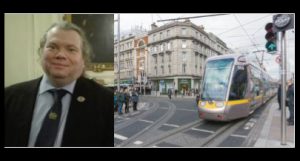 Anthony brought us up to date with operations and developments on the LUAS since its opening in 2004 – extensions to Brides Glen, The Point and Saggart, lengthened trams, accidents etc. and most recently the construction of tracks through the city centre to extend the Green Line to Broombridge. He showed how the LUAS has been embraced by Dubliners to become an integral and vital part of city life.
Anthony brought us up to date with operations and developments on the LUAS since its opening in 2004 – extensions to Brides Glen, The Point and Saggart, lengthened trams, accidents etc. and most recently the construction of tracks through the city centre to extend the Green Line to Broombridge. He showed how the LUAS has been embraced by Dubliners to become an integral and vital part of city life.
- 08 February 2018 (Dublin) – “Full Steam Ahead at the Bluebell” by Dick Fearn
Dick Fearn returned to Dublin to talk about his current role as Chairman of the Bluebell Railway, the pioneer line in standard gauge steam preservation in Britain.
Former Chief Executive of Irish Rail, Dick Fearn, once again returned to the IRRS to give our members another presentation, titled “Full Steam Ahead at the Bluebell”, but this time in his new role of Chairman of the Bluebell Railway in the UK. He gave a fascinating account of the developments on the railway, new projects, and general day-to-day operations and challenges faced. He also included details of special events at the railway including filming scenes of the British period drama, Downton Abbey and a visit to the railway by the Flying Scotsman. At the end of the presentation, he extended an invitation to IRRS members to visit as a group in the near future (which is being actively considered). A total of 65 members attended.
- 25 January 2018 (Dublin) – Members Slideshow: European & Overseas subjects
The second instalment of the annual members slideshow took place, covering European and overseas topics. A total of seven members presented images on the night, both in digital and traditional slide format, and covered many countries from Europe, the US and beyond. An enjoyable evening was had by all at the well-attended event.
- 18 January 2018 (London) – “Port, Harbour and Military Railways” by Andrew Waldron
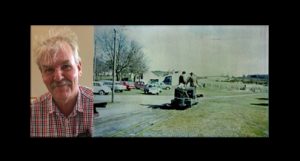 Andrew Waldron gave us another entertaining talk on Irish industrial railways, beginning with a comprehensive look at the railways around Belfast docks. Showing the wide variety of traffic on those lines including large pieces of equipment for ships being built by Harland and Wolff, Andrew then showed those around the Port of Derry.
Andrew Waldron gave us another entertaining talk on Irish industrial railways, beginning with a comprehensive look at the railways around Belfast docks. Showing the wide variety of traffic on those lines including large pieces of equipment for ships being built by Harland and Wolff, Andrew then showed those around the Port of Derry.
He covered many well-known uses of rail in industry, North and South, and others less well-known. It seemed that anywhere rail was used to shift something, Andrew has been to see and photograph it! Appropriately, as we remember the centenary of the outbreak of World War One, Andrew introduced us to various rail systems in military establishments, including a remarkable line at the Curragh – on the target range! If that wasn’t enough, the number of different gauges utilised was almost beyond belief.
A very informative presentation, at which everyone learned something new.
- 11 January 2018 (Dublin) – “Austrian Adventures” a slideshow of Austrian scenes presented by Clifton Flewitt
Clifton Flewitt gave his annual presentation to the Society, in his now almost regular slot of early January, this year in the format of a slideshow, titled “Austrian Adventures”, covering a wide range of railway aspects from standard gauge to narrow gauge to trams, and even some paddle steam boats made an appearance! Despite the fact the Library was closed to members in January, it did little to put members off attending the Thursday evening events.
2017 Meetings
- 07 December 2017 (London) – “Engineering Railway Architecture –the GNR(I)” by Siobhan Osgood + AGM
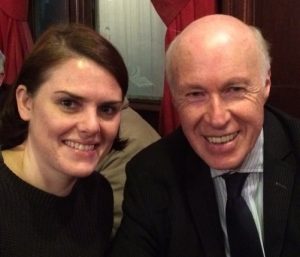 Using engaging visuals of original drawings alongside photos of current buildings, Siobhan detailed the development of the GNRI’s central engineering works at Dundalk focussing on the work of its first chief engineer, William Hemingway Mills. Starting with the engineering works Siobhan linked key architectural features across residential and railway station buildings, including those inherited from the earlier site and those constructed by the GNRI.
Using engaging visuals of original drawings alongside photos of current buildings, Siobhan detailed the development of the GNRI’s central engineering works at Dundalk focussing on the work of its first chief engineer, William Hemingway Mills. Starting with the engineering works Siobhan linked key architectural features across residential and railway station buildings, including those inherited from the earlier site and those constructed by the GNRI.
Following the talk was a lively question and answer session leading to discussions about other sites which use Mills’ brick-branding style such as Lisburn station. The embedded signage of Stuart’s Granolithic also made an appearance at a member’s school in Surrey!
Following the talk were complimentary Christmas drinks and the London Area AGM.
- 16 November 2017 (London) – “Ireland’s Great Railway Engineers” by Gerald Beesley
Gerald Beesley gave us a remarkable insight into the lives of over fifteen Irish railway engineers, from the far-famed like Charles Clifford of the GNR(I) to the less well-known like Mervyn Ryan from Thurles whose work was mainly in South America.
In between, we had Robert Ross, inventor of the wonderfully named Ross “Pop” Safety Valve, and Bartolomew Kelliher from Castleisland who designed and built many bridges in North America. In his talk, punctuated by many entertaining narratives, Gerard demonstrated the remarkable connections between many of his subjects, whether through school – Stonyhurst was Alma Mater to Ryan mentioned above and Roche who worked on the LSWR – or by birth, for Robert Ross’s mother was first cousin to William Traill of Giant’s Causeway Tramway fame.
A lively, carefully researched talk which added much to the writer’s knowledge of Irish engineers.
- 19 October 2017 (London) – “Graham Hoare’s Irish Railway Photos” presented by Roger Joanes
Graham was an English railway enthusiast, who travelled extensively in Ireland between 1956 and 1964, taking a special interest in lines and stations then threatened with closure. He bequeathed his 2,000 photos to the IRRS and a selection were presented by Roger Joanes, a frequent visitor to Ireland himself since 1960.
- 16 March 2017 (London) – “Irish Steam in the 1960s” by Conrad Natzio
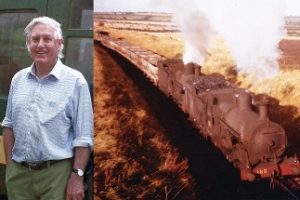 Conrad began his talk with a quiz, making good use of his wide selection of Irish photographs, mainly taken in the 1950s and 1960s – needless to say won by a senior Irish member who was on some of the trains!
Conrad began his talk with a quiz, making good use of his wide selection of Irish photographs, mainly taken in the 1950s and 1960s – needless to say won by a senior Irish member who was on some of the trains!
Conrad was at Trinity in the late 1950s and early 1960s and he explained how he travelled far and wide in search of the remaining Irish steam workings, aided latterly by a secondhand van which appeared in at least one photograph! As well as well-known mainline activity, he recorded the “seaside” excursions run on the Great Northern lines to take Dubliners to the seaside and the remarkable three day ballast cycle which was steam worked from Lisduff quarry until the early 1960s.
An evocative view of the past, illustrated by superb photographs with a lively commentary full of anecdotes.
- 16 February 2017 (London) – “Midland (north) and Midland (south)” by Tony Ragg and Richard McLachlan
Part 1 – Two contrasting Locomotive Engineers – Tony Ragg
Tony Ragg described the careers of the remarkable Bowman Malcolm who became Loco Superintendent of the B&NCR when just 22 years old, and one of his successors, Percy Stewart, who just happened to be Tony’s grandfather.
Tony structured his account under three headings – Family, Engineering and Retirement.
Malcolm is justly famous for his espousing compounding (encouraged by Lang of Beyer Peacock) and especially the two-cylinder variety. Malcolm tested otherwise identical locos working as simples and as compounds and found the latter 12% more economical. He also introduced automatic vacuum brakes to the B&NCR, in advance of governmental demands after the Armagh Disaster. As a Civil Engineer, he rebuilt the Bann Bridge at Coleraine.
While working to Wall, the Civil Engineer, Percy Stewart was effectively the Loco Engineer and was responsible for the rebuilding of many earlier locomotives into the famous “Whippets”. He became Loco and Civil Engineer in 1930 and supervised the building of the Bleach Green viaducts – Ireland’s only “flyover junction” and an enduring legacy to him. Unhappily, he died before it was completed.
He clashed with the NCC’s Manager Major Malcolm Spier over the direction to be taken by his department. Stewart wanted a variant of the famous Midland Compounds, but Spier was insistent on a mixed traffic loco and of course had his way with the famous “Moguls”.
Percy Stewart resigned in 1932, suffering from ill health, and died the following year after a very short retirement. Malcolm, on the other hand, had enjoyed a long retirement, but died the same year as his less well-known, but worthy pupil.
Part 2 – MGWR Curiosities – Richard McLachlan
Richard McLachlan explained his role as assistant archivist (drawings) which meant that he was busy digitising botht the existing drawings in the Archive, but also a number of collections either bequeathed or loaned to the Society. Among these were many drawings and documents apertaining to the Midland Great Western Railway of Irealand. These were the subject of his talk to the Area.
He explained that he found many railway histories a bit dry, leaving him wondering just what it was like to be a passenger on the trains of yesteryear. A study of the documents in the Archive was starting to provide him (and us) with the answers.
Illustrating his talk with maps, working timetables, and rolling stock returns, Richard explained that the MGWR at its peak had 139 locomotiveas and less than 200 coaches. This seemed few for such an extensive network of lines, but a glance at the timetables showed why these sufficed – typically just three or four passenger trains each way per day on each line!
He then went on to show astonishingly-detailed drawings of all manner of passenger rolling stock from the lowly third (which looked to have better seating than some London suburban trains these days!) to the oppulence of the bogie First Class carriages, right down to the provision of toilets. He described the evolution of horseboxes (an important traffic for the Railway) showing that the equine passengers seemed to fare better than the grooms accompanying them!
Concluding, Richard showed a number of very detailed civil engineering plans showing exactly where the railway passed through the countryside. His talk provoked lively comment and questions from the floor – an enlightening presentation.
2016 Meetings
- 10 November 2016 (London Embassy) – “70 years of development of the Irish Rail system” by Oliver Doyle, plus the “70th Anniversary of the IRRS”
The London Area of the IRRS celebrated the 70th anniversary of the society in the splendid surroundings of the Irish Embassy in London.
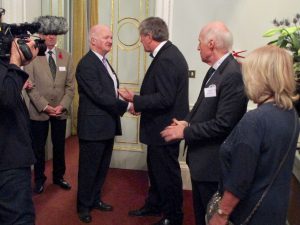 His excellency, Ambassador Dan Mulhall opened the evening’s event by greeting guests at the top of the stairs leading to the ballroom. He spoke about the shared experiences of railwaymen in Britain & Ireland and the old experiences of Irish people travelling to Britain, arriving at Euston & Paddington off ferries to Holyhead & Pembroke. He concluded his welcome with an excerpt from James Joyce’s “A Portrait of the Artist as a Young Man”, about Stephen Dedalus’ experience on the mail train from Dublin to Cork.
His excellency, Ambassador Dan Mulhall opened the evening’s event by greeting guests at the top of the stairs leading to the ballroom. He spoke about the shared experiences of railwaymen in Britain & Ireland and the old experiences of Irish people travelling to Britain, arriving at Euston & Paddington off ferries to Holyhead & Pembroke. He concluded his welcome with an excerpt from James Joyce’s “A Portrait of the Artist as a Young Man”, about Stephen Dedalus’ experience on the mail train from Dublin to Cork.
IRRS Board member, Alan Hyland, gave a brief history of 70 years of the society, from its initial inception & humble beginnings through to modern times and the introduction of an eJournal. There was a palpable swell of pride among members in the room as he spoke of the community of Irish rail enthusiasts.
London Area’s Chairman Tim Morton spoke about the Area’s regular activities, (which are set out elsewhere in this website) and gave a history of the Area from its earliest days when Lance King established the Society in London in 1961. He explained how the London Area maintains close relations with the Parent Body in Dublin through financial support for archiving activity there, expanding the Society in Britain through attracting new members to its meetings, and in handling bequests to the Society received from members and friends based in England.
Leslie McAllister presented the Ambasador with a specially bound version of Steaming in Three Centuries, a book published by the London Area.
Oliver Doyle, recently retired Operations Manager for Irish Rail gave a fascinating presentation of Irish Railway history over the 70 years of the Society’s existence. He highlighted many key changes in the railway system over that time, generously illustrated by photographs from his time with Irish Rail, including his own involvement in many of the projects described.
Oliver’s talk was followed by drinks & networking among those present. Notable guests included Phil Gaffney (Chair of Irish Rail), current & previous CEOs of Irish Rail, David Franks & Dick Fearn, Lord Faulkner of Worcester (President of the Heritage Railway Association), Gerald Beesley (Commissioner for Railway Regulation in Ireland), and about 100 IRRS members from both Ireland and Great Britain.
All present greatly enjoyed this very special occasion, the hospitality of the Ambassador and the Embassy, and the opportunity to enjoy the camaraderie of many fellow IRRS members and others. It was unique in the history of the London Area and it was a memorable evening for all who attended. Click here for a short excerpt featuring the IRRS event on the night.
- 13 October 2016 (London) – “Broad and Narrow Gauge in the 1950’s” by Michael Davies
Michael opened the evening with a wonderful stories of his early excursions to Ireland as a teenager, stories delivered with such clarity, he may have only travelled last week instead of nearly seventy years ago!
He shared anecdotes of making lifelong friends, of characters he met along the way and the journeys he took. Micheal then presented some of his extensive slide collection, including many mono-chrome slides from his own collection and colour slides he has gathered during his life.
Two slides stood out for me, the first showing the wreckage of a car having been hit at a level crossing; the second was as slide he had purchased only to realise after buying it, he was the person standing on the platform. Michael’s charm & easy storytelling made the evening a most enjoyable one and Tim expressed his hope that Michael will return again to share more stories & slides in the future.
- 21 January 2016 (London) – “What lay behind the 1957 GNR(I) Closures” by Steve Rafferty
 Steve shared his wonderful insights into what lay behind the decisions to close many Great Northern Railway (Ireland) lines. Steve’s presentation included contemporary, 60 year old BBC Northern Ireland (NI) material which highlighted the key issues and sensitivities at the time.
Steve shared his wonderful insights into what lay behind the decisions to close many Great Northern Railway (Ireland) lines. Steve’s presentation included contemporary, 60 year old BBC Northern Ireland (NI) material which highlighted the key issues and sensitivities at the time.
Stopping frequently during the recording, Steve elaborated on the complex political, media and social discussions leading up to the 1957 closures as well as using the footage to share unique views of railways in Northern Ireland taken by BBC’s professional cameramen. Steve’s talk ended with a lively conversation about the political & economic realities of the day and Steve shared his own conclusion that ultimately, economic reasons lay at the heart of the decision to close the lines. Steve’s engaging style and excellent supporting material made for a very successful night with a capacity crowd of over 50 people in attendance.
2015 Meetings
- 10 December 2015 (London) – “The West Clare Railway” by Michael Walsh
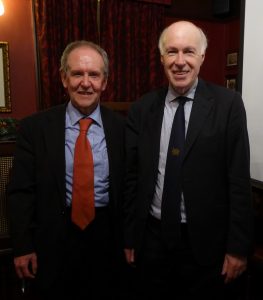 Michael, former IRRS Chairman, showed a collection of images shot in 1930s, including some West Clare vehicles at Inchicore works, together with a substantial number of images from the ‘Callender Collection’ showing views in the final years to closure in 1961. In addition, some contemporary scenes were included, recently taken by Ciaran Cooney, depicting extant buildings and how , in most instances, where they had been sympathetically adapted for modern day use; it was interesting to note some retain the station canopies.
Michael, former IRRS Chairman, showed a collection of images shot in 1930s, including some West Clare vehicles at Inchicore works, together with a substantial number of images from the ‘Callender Collection’ showing views in the final years to closure in 1961. In addition, some contemporary scenes were included, recently taken by Ciaran Cooney, depicting extant buildings and how , in most instances, where they had been sympathetically adapted for modern day use; it was interesting to note some retain the station canopies.
- 12 November 2015 (London) – “Keeping Irish Steam Alive – The Work of Heritage Engineering Ireland” by Peter Scott MBE
Peter gave a truly excellent talk. He spoke of his studies at the Royal Belfast Academical Institute (the ‘Inst’ – one of the components of the nascent RPSI in 1963) and after University, he joined NIR spending 30 years mainly in Special Projects until retirement 5 years ago. As the RPSI’s Loco Officer since 1972, that society owes Peter a huge debt in establishing Heritage Engineering Ireland Ltd (HEI), a wholly owned subsidiary that maintains the Society’s Locos and undertakes contract work for other concerns in the U.K. and Ireland.
Peter illustrated his talk with a fascinating selection of photos and videos of the many and diverse processes undertaken by the company, including forging replacement connecting rods, cross heads, smokeboxes, etc. During questions from the floor, Peter outlined the possibility of a new ‘Jeep’ similar to No 4, built from many parts that are ‘in-stock’, comparing this to the ‘new-build’ projects being undertaken elsewhere. Peter stated that the production of a second loco will greatly assist with the RPSI’s expanding programme of special trains operated throughout Ireland.
- 15 October 2015 (London) -“Reflections on NIR – looking back and looking forward” by Mal McGreevy MBE
Mal recently retired as NIR’s General Manager and offered unique insights into NIR’s success since the turn of the century. With investment in new CAF-built trains, park-and-ride schemes and station & track upgrades, this positive approach to improving rail services has been rewarded by more than a doubling of passengers.
Mal also set out the current vision for the future development of the rail system, including the ambitious Belfast Transport Hub beside Great Victoria Street station, aspirations for electrification and a 90-minute Belfast-Dublin Enterprise timing at speeds of up to 125 mph.
This is an exciting period for NIR and it was illuminating to hear about it from a company perspective.
- 16 April 2015 (London) – “Ulster Steam in the 1960’s : Some Untold Stories” by Joe Cassells
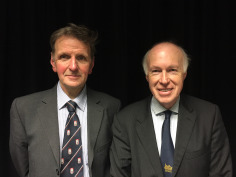 A lifelong observer of the Ulster railway scene, Joe Cassells, shared his intimate knowledge of UTA steam operations in the 1960’s and of the men who worked the railway.
A lifelong observer of the Ulster railway scene, Joe Cassells, shared his intimate knowledge of UTA steam operations in the 1960’s and of the men who worked the railway.
His wonderful presentation was Illustrated by his own photos and those of the late Irwin Pryce, including images of one coach locals, heavy freight on the Derry Road, 800t spoil trains, docks shunting, steam boat trains, Sunday excursions and much more, plus behind-the-scenes shots from railway workplaces such as footplates, sheds, stations and signal cabins. Joe’s talk was replete with insights, insider memories and rarely told stories and thoroughly enjoyed by all present.
- 19 March 2015 (London) – “Bord na Móna Railways Today” by Sean Cain
Bord na Móna carries over 3 million tons of peat each year on approx. 900km of track, hauled by locos ranging from Rustons built in the 1940s in Lincoln (which outlived more modern Andrew Barclay steam traction) to modern Irish built locos designed and built in house by Bord na Móna themselves.
Sean Cain (who works as a Traincare Technician with Iarnród Éireann) shhared his interest in the Bord na Móna Railways, with stories & photos dating back to childhood days in the 1980’s. He spoke of the large and small Bord na Móna operations across Munster, Connaght and Leinster and showed how they have evolved over the decades.
- 19 February 2015 (London) – “The North Kerry Line” by Alan O’Rourke
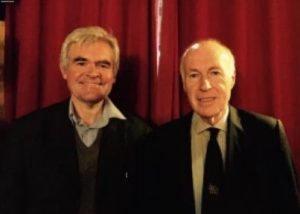 Alan spoke about the railway lines between Limerick, Tralee, Foynes and Fenit, covering construction in the 19th century, operation & traffic, decline and fall in the 20th century and recent resurrection as a walking & cycling Greenway for the 21st century. He presented some very odd stations and shared entertaining anecdotes about Newcastlewest’s very own runaway train and how the impecunious Rathkeale company almost got “one up” on the Board of Trade!
Alan spoke about the railway lines between Limerick, Tralee, Foynes and Fenit, covering construction in the 19th century, operation & traffic, decline and fall in the 20th century and recent resurrection as a walking & cycling Greenway for the 21st century. He presented some very odd stations and shared entertaining anecdotes about Newcastlewest’s very own runaway train and how the impecunious Rathkeale company almost got “one up” on the Board of Trade!
- 15 January 2015 (London) – “The Armagh Railway Disaster of 1889″ by Canon John McKegney + AGM
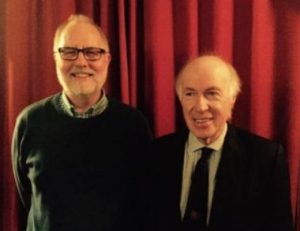 John’s presentation recalled the devastation of the 1889 Armagh Railway disaster with contemporary photographs and recordings of eye-witnesses of the event. John also shared his experience of meeting a “survivor”, a man forbidden from travelling on the day In his childhood and who recalled visiting the site of the accident and seeing the bodies of his friends.
John’s presentation recalled the devastation of the 1889 Armagh Railway disaster with contemporary photographs and recordings of eye-witnesses of the event. John also shared his experience of meeting a “survivor”, a man forbidden from travelling on the day In his childhood and who recalled visiting the site of the accident and seeing the bodies of his friends.
John gave insights into the effect of the accident on the community in Armagh and how it forced the government’s hand in introducing the first health & safety legislation for the railways.
The AGM that followed led to the re-election of the existing committee and a lively discussion about future venues and promoting the society to younger enthusiasts
2014 Meetings
- 04 December 2014 (London) – “A Classic and Colourful Journey on Irish Railways in the Early 1960s” by Ciaran Cooney
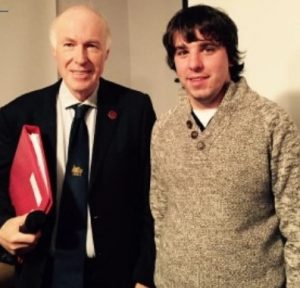 Railway photographer and IRRS Photographic Archivist, Ciaran Cooney, gave a wonderful presentation of the late Norman McAdams’s photo-collection, depicting both everyday and rare scenes throughout the Irish railway system during the early 1960s – all in colour, digitised and painstakingly restored to their superb original quality. Steam and diesel traction from CIE and GNR(I) featured, as well as a many lines now long since consigned to history.
Railway photographer and IRRS Photographic Archivist, Ciaran Cooney, gave a wonderful presentation of the late Norman McAdams’s photo-collection, depicting both everyday and rare scenes throughout the Irish railway system during the early 1960s – all in colour, digitised and painstakingly restored to their superb original quality. Steam and diesel traction from CIE and GNR(I) featured, as well as a many lines now long since consigned to history.
Ciaran also briefly described the digitisation of the IRRS collections, and the preparation of high quality photos for the Journal.
- 13 November 2014 (London) – “Ten Happy Years with Iarnrod Eireann – 2003 to 2013″ by Dick Fearn
Dick reflected on his time with Iarnrod Eireann, both as Chief Operating Officer from 2003 to 2006 and as Chief Executive from 2006 up to his retirement last year.
Having previously spent 30 years with the railways in the UK before moving to Ireland, Dick compared and contrasted the job of managing railways in the different cultural and political environments of the UK and Ireland. He shared many hilarious anecdotes of his encounters with Irish politicians and CIE board-members.
He spoke of the enjoyment he had in the job and talked fondly about some of the characters he met whilst living and working in Ireland over the past decade.
- 16 October 2014 (London) – “Railway Preservation Society of Ireland: Fifty Not Out” by Charles Friel BEM
Charles Friel has had many roles in the RPSI throughout its first 50 years. On October 16th, to an enthusiastic and appreciative audience (who were not afraid to share their own anecdotes) he celebrated the hard work of his fellow, determined amateurs (many of whom are still active) on the long road to establishing today’s self-sufficient heavy engineering base, and running 71 main line trains and attracting over 20,000 visitors in 2013. RPSI steam trains have visited every corner of the system and Charles recalled many almost-forgotten episodes and first time events. He also gave a glimpse of what is envisaged for the next 50 years.
